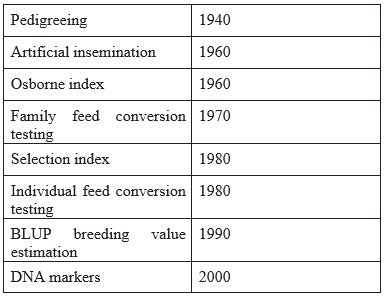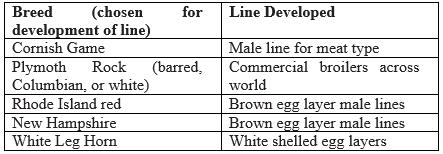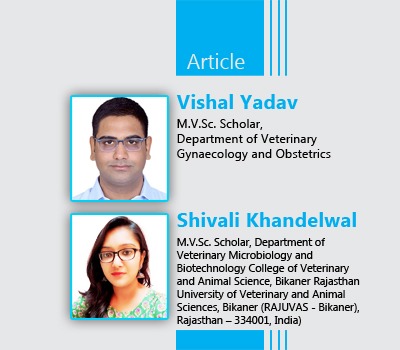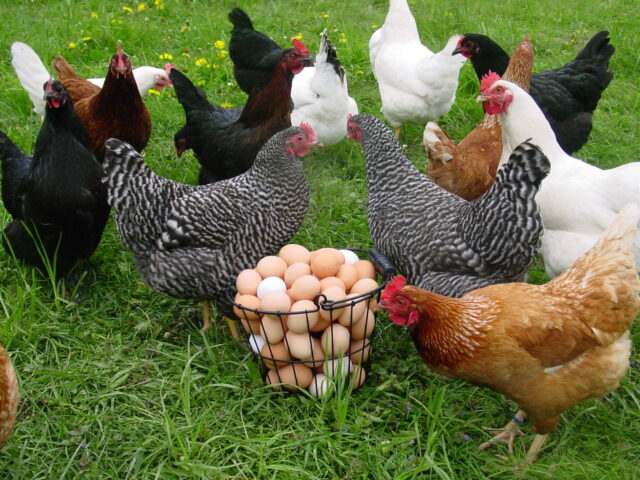Advancement in science and technology has resulted in the development of the poultry sector to new heights. Genetically superior stocks having high rate of production even under environmental stress lead to remarkable changes in poultry rearing and production (from rural farming to well organized industry within 40 years). Rise in production capacity and per bird productivity has become mainly possible due to CCPS (combined crossbred and purebred selection). Using specialized crossbreeding program, the superior purebred lines were analysed for their nicking ability, and the best nicking male and female lines were used to develop four-way commercial crosses.
As molecular techniques get to be advanced, the DNA marker technology has being developed as a precise tool for evaluating genetic variability. Genome-wide scan by microsatellites lead to the identification of quantitative trait loci (QTL) for their use in marker-assisted selection (MAS). The single nucleotide polymorphisms (SNPs) were discovered as third-generation of genetic markers. Thanks to “next generation sequencing” technique that led to the development of high-density SNP arrays as a powerful tool for genetic analysis. Forecasting genomic estimate of breeding value (GEBV) of individual using SNPs throughout the entire genome open the way to conceptualize the “genomic selection” which evolved as the most advanced technology to revolutionize poultry production.
Selection Methods and Breeding Programmes
The selection and breeding program in poultry science has been kept on changing depending on necessity and knowledge gain during the decades (Table1).


The individual poultry flocks were analyzed and the selected birds were retained and the surplus culled birds were marketed as an end product in the 1940s. In the 1980s, the concept of two, three, or four-way crosses was adapted which revolutionized poultry breeding for the development of the high-yielding modern layer and broiler strains. The Specialized egg and meat type birds replaced dual type birds and also the purebreds were replaced by commercial hybrids as a terminal cross. Specialized male and female lines both in layer stocks and broiler stocks having very different foundation genetic sources were developed in egg type stocks and meat type stocks as necessitised by negative correlations in reproduction and production (Table 2).

*The modern commercial lines across the world are now a composite of the founding breeds having minor contributions from other suitable breeds. Hence, the recent poultry breeding involves both crossbreeding programs and pure line selection (PLS). Therefore, the selection in poultry breeding is combined with crossbred and purebred selection (CCPS). Crossbred performance and purebred performance are considered as genetically correlated traits assuming the infinitesimal model.
Based on genetic parameters like correlations and heritability values, the phenotypic selection is the method that primarily followed for body weight improvement, however, the index selection (Osborne index) was employed for egg production in pure line selection (PLS). The number of traits are now included in the selection program, the modern programs, therefore, rely on breeding value estimation with animal model best linear unbiased predictor (BLUP).
Molecular Approaches
Milestone in genetics by discovery of double helical model of DNA by Watson and Crick, the molecular genetics approaches begin to revolutionize the era of poultry breeding. In 1970s, molecular genetics originated new opportunities to improve breeding programs using DNA markers linked with traits of interest. Type I (RFLPs, ESTs, and SNP) and Type II (RAPDs, micro, and minisatellites, AFLP, etc.) markers were identified. As type II markers are highly polymorphic and abundant in the genome, are more preferred, however, the use of SNPs, the third generation marker is also becoming popular in various genetic applications including :
i. QTL (quantitative trait loci) identification and genome wide scans
The genetic control of quantitative traits is expected to be distributed throughout the genome and the various regions of the genome, which control the quantitative traits of interest, were described as (QTL).
ii. Candidate gene approach
The gene with a direct and large effect on the trait of interest is considered as “candidate gene” .
iii. High-density SNP (Single nucleotide polymorphisms) genotyping for whole genome selection
Single nucleotide polymorphisms, frequently called SNPs (pronounced “snips”), are the most common type of genetic variation among people. Each SNP represents a difference in a single DNA building block, called a nucleotide. For example, a SNP may replace the nucleotide cytosine (C) with the nucleotide thymine (T) in a certain stretch of DNA.
Also, read | Managing Gut Health, a Multi-Factorial Approach
Authors:

Vishal Yadav1* and Shivali Khandelwal2
1M.V.Sc. Scholar, Department of Veterinary Gynaecology and Obstetrics
2M.V.Sc. Scholar, Department of Veterinary Microbiology and Biotechnology
College of Veterinary and Animal Science, Bikaner
Rajasthan University of Veterinary and Animal Sciences, Bikaner (RAJUVAS – Bikaner), Rajasthan – 334001, India
*Corresponding author: Vishal Yadav (M.V.Sc. Scholar), email: vishalyadav1131997@gmail.com















